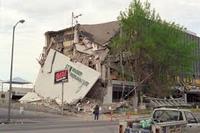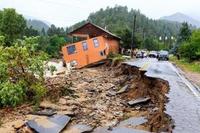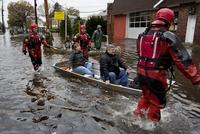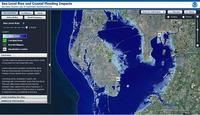-
U.K. facing flood crisis, as prime minister warns victims they are in for “long haul”
David Cameron warns flooding victims that they are in for a “long haul,” as the weather service says the weather will get worse this week, leaving thousands more homes at risk. There is a growing anger at the government by residents who complain that in addition to lack of preparation and response – thus, there were many complaints that sandbags intended for the worst-hit areas being “hijacked” and unavailable to stem the rising water – government agencies have not provided enough security after resident were ordered to evacuate, leading to looting of vacant homes. Officials have predicted that thousands more homes will be flooded over the coming days and said restoring the country’s battered rail network could take months.
-
-
Coastal areas must adapt to sea-level rise and storm surges or suffer massive damage
A new study presents, for the first time, comprehensive global simulation results on future flood damages to buildings and infrastructure in coastal flood plains. Drastic increases in these damages are expected due to both rising sea levels and population and economic growth in the coastal zone. Asia and Africa may be particularly hard hit because of their rapidly growing coastal mega-cities, such as Shanghai, Manila, and Lagos.
-
-
Quake-vulnerable concrete buildings in Los Angeles area identified

Researchers have identified nonductile concrete buildings constructed before roughly 1980 in the Los Angeles area. This category of buildings is known from experience in previous earthquakes to have the potential for catastrophic collapse during strong earthquakes. Nonductile concrete buildings were a prevalent construction type in seismically active zones of the United States before the enforcement of codes for ductile concrete which were introduced in the mid-1970s. A companion study estimates that approximately 17,000 nonductile reinforced concrete buildings are located in the most highly seismic areas of California. More than seventy-five million Americans in thirty-nine states live in towns and cities at risk for earthquake devastation.
-
-
Israel considering earthquake-proofing important Biblical-period structures
Israel is located in one of the world’s earthquake-prone areas, along the friction point of the African and Arabian tectonic plates.Officials in Israel are taking preventative measures to protect the country’s most important ancient sites from earthquake damage. Engineers from the University of Padua in Italy have installed sensors throughout the Tower of David, one of Jerusalem most important historical sites, to determine what sort of earthquake-proofing may be needed. Some experts opined that in the event of an earthquake, Jerusalem’s most ancient structures might actually be the city’s most dependable. “If they still stand after so many earthquakes during the last 2,000 years, they must be good structures,” one of them said.
-
-
New L.A. fault map threatens Hollywood development projects
The state of California recently released new geological maps which reveal the presence of an active earthquake fault along the path of major developments in Hollywood. The maps established a zone of 500 feet on both sides of the fault, and state law will require new developments within the zone to conduct underground seismic testing to determine whether the fault runs beneath planned development sites. Building on top of faults is prohibited. Three prominent Hollywood developments — the Millennium Hollywood skyscraper project, the Blvd6200 development, and an apartment project on Yucca Street — are within the 500-foot fault zone.
-
-
Zapping bridges with electricity to test for corrosion
One out of nine of the nation’s bridges is structurally deficient and that more than 30 percent of bridges have exceeded their 50-year design life; the average age of the nation’s bridges is currently forty-two years. Motorists in the United States make more than 200 million trips across bridges rated structurally deficient or in need of significant maintenance and yearly inspection. Of the more than 17,000 bridges in New York, 12.5 percent are structurally deficient and 27 percent are considered functionally obsolete. One major culprit for bridges’ deterioration: corrosion of reinforcing steel. New testing method could replace expensive, time-consuming visual inspections.
-
-
Colorado faces costly, lengthy challenge fixing flood-damaged roads

The Colorado Department of Transportation(CDOT) has met the 1 December 2013 deadline to reopen twenty-seven flood-battered highways in the state, but the department still faces major challenges in making permanent fixes to damage caused by September’s historic floods. The scope of the task is currently being evaluated as highway managers explore technological and engineering changes needed to keep about 485 miles of damaged roadway more resistant to mass flooding.
-
-
NIST: Joplin tornado highlights need for building design, construction standards
Nationally accepted standards for building design and construction, public shelters, and emergency communications can significantly reduce deaths and the steep economic costs of property damage caused by tornadoes. That is the key conclusion of a two-year technical NIST investigation into the impacts of the 22 May 2011 tornado that struck Joplin, Missouri. Report and recommendations released for public comment.
-
-
List of most-at-risk L.A. buildings to be released
Scientists have compiled a list of concrete buildings in Los Angeles which could be at risk of collapsing in a major earthquake. The list identifies about 1,500 concrete structures built before 1980 which need further study to determine their risk level. Structural engineers insist that hundreds could die if any of the buildings collapsed.
-
-
The Philippines is victim of geography, poor infrastructure, poverty
Owing to its location and geography, the Philippines is one of the most natural disaster-prone countries in the world. On average the country experiences nine major typhoons and 900 earthquakes annually, and it has twenty-five active volcanoes. Poor infrastructure and pervasive poverty exacerbate the impact of disasters, making them even more deadly and destructive. “In a cruel cycle, poverty and underdevelopment make disasters worse, and disasters make poverty and underdevelopment worse,” one observer notes.
-
-
Resources on disaster preparedness, resilience

One year after Superstorm Sandy hit the eastern United States, local, state, and federal agencies as well as community groups and businesses are working to strengthen the U.S.s resilience to future disasters. A National Research Council (NRC) has issues a series of studies and reports, and has put together workshops and study groups, which should advance the national conversation on preparedness and resilience.
-
-
Urban underground water can be used for sustainable energy
Vast energy sources are slumbering below big cities. Sustainable energies for heating in winter and cooling in summer may be extracted from heated groundwater aquifers. Researchers developed an analytical heat flux model and found that increasing heat in the underground is mainly caused by an increase in surface temperatures and heat release from buildings.
-
-
New method to help coastal communities adapt to sea-level rise

Future sea-level rise seems inevitable, although the rates and geographical patterns of change remain uncertain. Given the large and growing populations and economic activity in coastal zones, as well as the importance of coastal ecosystems, the potential impacts of sea-level change are far-reaching. Current methods to assess the potential impact of sea-level rise have varied significantly and hindered the development of useful scenarios and, in turn, suitable adaption policies and planning.
-
-
Guardrails made safer with impact-absorbing Mediterranean tapeweed coating
Researchers have developed protective guardrails from residue of Posidonia oceanica,commonly known as Neptune Grass or Mediterranean tapeweed, in order to minimize the risk of injuries on the roads. The waste material is useful for coating the support posts of guard rails on roads so they can absorb and dissipate much of the kinetic energy if a collision occurs, preventing lacerations and amputations in cases in which a human body hits the support post.
-
-
Crumbling infrastructure hobbles U.S. competitiveness

America’s infrastructure has long been denied the investment and attention needed from public and private entities to remain competitive in an ever-growing global economy. U.S. roads, bridges, power plants, airports, utilities, and other critical infrastructure were once the envy of the world. The post-Second World War golden era (that is, golden era as far as investments in infrastructure are concerned) has come to an end, and fewer resources are committed to improving and maintaining the country’s infrastructure.
-
- All
- Regional
- Water
- Biometrics
- Borders/Immig
- Business
- Cybersecurity
- Detection
- Disasters
- Government
- Infrastructure
- International
- Public health
- Public Safety
- Communication interoperabillity
- Emergency services
- Emergency medical services
- Fire
- First response
- IEDs
- Law Enforcement
- Law Enforcement Technology
- Military technology
- Nonlethal weapons
- Nuclear weapons
- Personal protection equipment
- Police
- Notification /alert systems
- Situational awareness
- Weapons systems
- Sci-Tech
- Sector Reports
- Surveillance
- Transportation
Advertising & Marketing: advertise@newswirepubs.com
Editorial: editor@newswirepubs.com
General: info@newswirepubs.com
2010-2011 © News Wire Publications, LLC News Wire Publications, LLC
220 Old Country Road | Suite 200 | Mineola | New York | 11501
Permissions and Policies
Editorial: editor@newswirepubs.com
General: info@newswirepubs.com
2010-2011 © News Wire Publications, LLC News Wire Publications, LLC
220 Old Country Road | Suite 200 | Mineola | New York | 11501
Permissions and Policies
